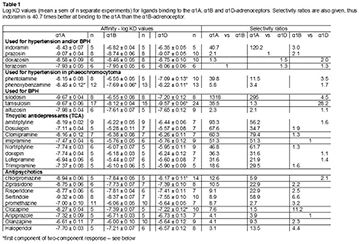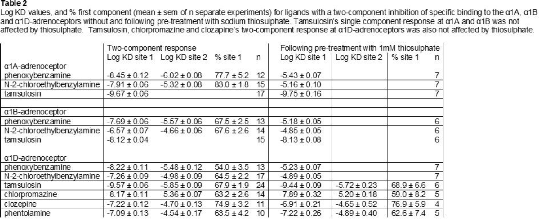| 115P London, UK Pharmacology 2017 |
The selectivity of clinically used α-adrenoceptor antagonists, antidepressants and antipsychotics for the human α1A, α1B and α1D-adrenoceptors.
Introduction: α-adrenoceptor antagonists are used in the management of benign prostatic hyperplasia (BPH) and hypertension with several α-antagonists approved for both conditions in the UK (1). They have a range of reported α1-subtype selectivities but there is also significant regional variation, with “non-selective” agents preferred for BPH in some countries and “subtype selective” agents used in others (2). Also the α1-antagonists used to manage hypertension differ from those agents use for hypertension in phaeochromocytoma (1). Furthermore, several antidepressant and antipsychotic agents have also been shown to have α1-adrenoceptor affinity (3, 4). This study therefore examined the selectivity of clinically used α-antagonists for the three subtypes of human α1-adrenoceptors – α1A, α1B and α1D.
Methods: The DNA for each of the human α1-adrenoceptors (3) was transfected into CHO-K1 cells and stable cells lines isolated by dilution cloning. 3H-prazosin whole cell binding was conducted (see (5) for full binding method, incubation was 2hr 37°C).
Results: The affinity (KD value) for 3H-prazosin was 0.71 ± 0.07nM (n=11) for the α1A, 0.87 ± 0.11 (n=12) for the α1B and 1.05 ± 0.10 (n=20) for α1D-adrenoceptor. Silodosin was the ligand with highest affinity and selectivity however some antidepressants (e.g. amitriptyline and clomipramine) and antipsychotics (e.g. chlorpromazine and risperidone) had equally high affinity for the α-adrenoceptors as those used in hypertension and BPH – see Table 1. Phenoxybenzamine inhibited 3H-prazosin binding in a manner best described by two-components (Table 2, Figure 1). It cyclizes in solution to form the active ethyleniminium derivative (6). Sodium thiosulphate binds ethyleniminium ions thus preventing it from binding to the receptor (6). Pre-incubation of phenoxybenzamine with 1mM thiosulphate (30min, 37°C) before addition to the cells abolished the high affinity component of binding, confirming the ethyleniminium derivative to be that interacting with the α-adrenoceptors. Thiosulphate pre-treatment had no effect on the binding of other ligands (Table 2).
Conclusion: The drugs used for hypertension and BPH are a mixture of α1A-selective and non-selective ligands. Several antidepressants and antipsychotic drugs have equally high α1A-adrenoceptor affinity. Maybe careful choice of ligands in people with more than one disorder may reduce polypharmacy.
References
(1) British National Formulary 72 (2016-2017)
(2) Batty M et al., (2016) Int. J. Mol. Sci. 17: 1339
(3) Nojimoto FD et al., (2010) Neuropharmacology 59: 49-57
(4) Nourian Z et al., (2008) Psychopharmacology 199: 15-27
(5) Baker JG (2005) Br J Pharmacol. 144: 317-322.
(6) Graham JDP (1957) Br J Pharmacol. 12: 489-497.




